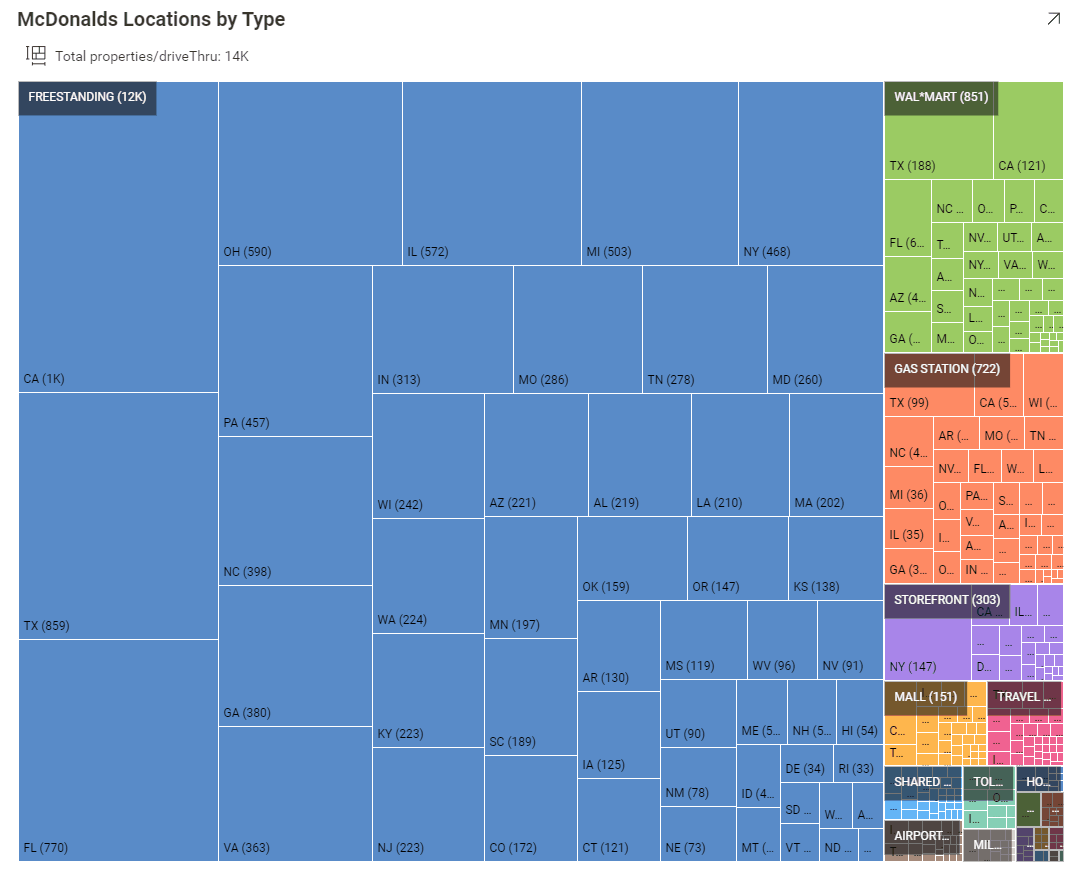
요약:
트리맵 차트는 다양한 크기와 색상의 중첩된 노드(직사각형)를 사용하여 계층적 데이터를 표시하는 데이터 시각화로 데이터 패턴을 쉽게 파악하거나 데이터 수량을 비교할 수 있습니다.
트리맵은 "분포" 시각화로 분류되는 경우가 있지만, 전체(전체) 값을 더하는 데이터 세트의 범주(부분)를 표시하는 "부분-전체" 시각화라고 합니다.
범주는 분석 중인 총 값에 대한 값 백분율을 기준으로 다른 범주에 비례하여 표시됩니다.
틀림없이 가장 인기 있는 부분-전체 시각화와 달리 파이 차트, 트리맵 차트는 드릴다운 시나리오용으로 설계되었습니다. 둘 이상의 수준(직사각형으로 표시됨)에서 데이터 포인트의 상대적 가중치를 표시하여 보다 효율적인 분석을 위해 더 작은 직사각형으로 표시되는 데이터 세트를 지속적으로 더 깊이 드릴다운할 수 있습니다.
동시에 트리맵은 숫자 수량을 전달하도록 설계되지 않았습니다. 의도는 데이터 세트 값의 상대적 순위 및 상대적 차이를 표시하는 것입니다.
제곱 트리맵
원래 하드 드라이브의 파일을 시각화하기 위해 설계된 트리맵은 재무 분석에서 스포츠 리포팅에 이르기까지 다양한 도메인에 적용되었습니다(Ordered Treemap Layouts, Ben Shneiderman, Martin Wattenberg, http://www.cs.umd.edu/hcil/treemap-history/). 트리맵 구조로 데이터를 표현하기 위해 Squarified, Slice and Dice, Stripped와 같이 선택할 수 있는 알고리즘이 여러 가지 있으며, 가장 일반적인 것은 Squarified Treemap 알고리즘입니다. Reveal 모든 화면 크기(데스크톱, 웹, 모바일)와 종횡비가 낮은 기기에서 잘 작동하는 Squarified Treemap 알고리즘을 사용합니다.
다음은 Reveal의 정사각형 트리맵의 예로, 유형별로 맥도날드 매장을 보여줍니다.
이 예에서 트리맵은 주별 맥도날드 매장 유형(독립형, 주유소, 쇼핑몰 등)의 수(개수)에 대한 세부 정보를 보여줍니다. Reveal 임베디드 분석을 사용하면 주별 개수와 같이 각 범주에 대한 툴팁에서 추가 정보를 얻을 수 있으며, 각 트리맵 범주(주 이름)로 드릴다운하여 주 수준 요약을 빠르게 분석할 수 있습니다. 드릴다운 횟수는 데이터에 의해서만 제한됩니다. 예를 들어, 도시 또는 카운티에 대한 추가 트리맵 계층을 추가한 경우 추가 분석 및 드릴다운을 수행할 수 있습니다.
트리맵 차트 시각화 사용에 대한 모범 사례
다른 데이터 시각화와 마찬가지로 트리맵 차트 시각화는 특정 시나리오에서 사용해야 합니다. 바 차트 나 선형 차트와 같은 시각화와 동일한 문제는 해결되지 않습니다. 실제로는 더 복잡하고 풍부한 데이터 표시를 위한 것입니다.
트리맵 차트를 사용하는 경우
- 드릴다운 계층 데이터(분기 및 하위 분기가 있는 트리로 구성된 데이터)
- 범주(분기)와 하위 범주(하위 분기) 간의 상대적 가중치 및 비교 값의 계층 구조를 설명합니다.
- 작고 공간 효율적인 시각화가 필요한 대규모 데이터 세트 표시
- 정확한 값 없이 빠른 데이터 분석을 한눈에 전달하고 싶을 때. 사각형의 상대적인 크기는 패턴 및/또는 이상값을 매우 빠르게 식별하는 데 도움이 됩니다.
- 공간을 효율적으로 사용하기 위해. 트리맵은 동시에 화면에 수천 개의 항목을 읽기 쉽게 표시할 수 있습니다.
트리맵 차트를 사용하지 않는 경우
- 정확한 값이 필요한 데이터 스토리를 전달하는 경우
- 음수 데이터 값이 있는 경우
- 평면적이고 비계층적인 데이터가 있는 경우(드릴다운 없이 트리맵을 사용해도 괜찮지만 데이터 스토리에 사용하기에 가장 적합한 데이터 시각화가 아닐 수 있습니다.
- 데이터 크기가 비슷한 경우, 즉 사용자가 동일한 크기의 사각형을 보게 되는 경우 위에 나열된 트리맵 모범 사례에 위배됩니다.
트리맵 시각화와 함께 사용되는 데이터의 예
트리맵은 작고 공간 효율적인 방식으로 표시해야 하는 매우 다양한 양적 값이 있는 더 큰 데이터 세트에 가장 적합합니다. 트리맵에 대한 데이터 시나리오에는 다음이 포함될 수 있습니다.
- 카운티별 선거 결과 또는 카운티별 정당별 득표수
- 카테고리별 제품 판매, 국가별 하위 카테고리
- 기술별 / 지역별 / 기타 제품별 시장점유율
- 제품 카테고리 국가별 수출
- 제품별 부문별 매출
Reveal에서 트리맵 차트 사용
Reveal Treemap Chart에 대해 자세히 알아보려면 다음과 같은 유용한 리소스를 사용해 보세요.
- 비디오 –트리맵 시각화 생성
- 문서 –Reveal 트리맵 사용
Reveal에서 첫 번째 트리맵을 시작하려면 https://app.revealbi.io로 가서 무료 평가판에 가입하세요!
Is there a visualization that you’d like which isn’t in Reveal? Shoot me an email at casey@revrealbi.io and let me know!
감사해요!
케이시






